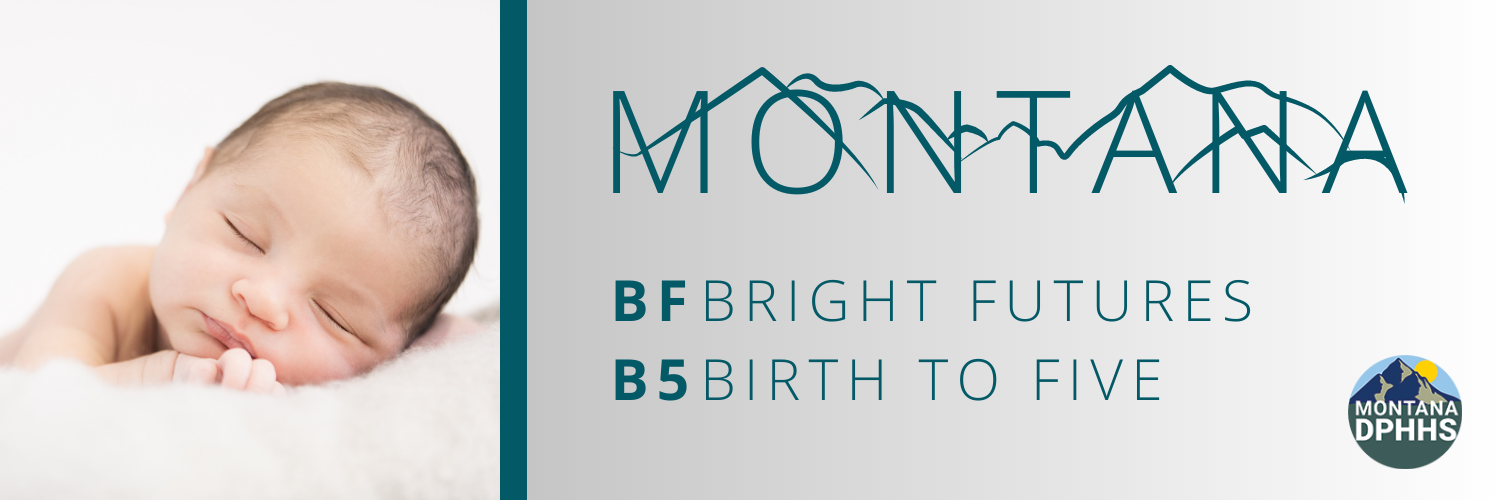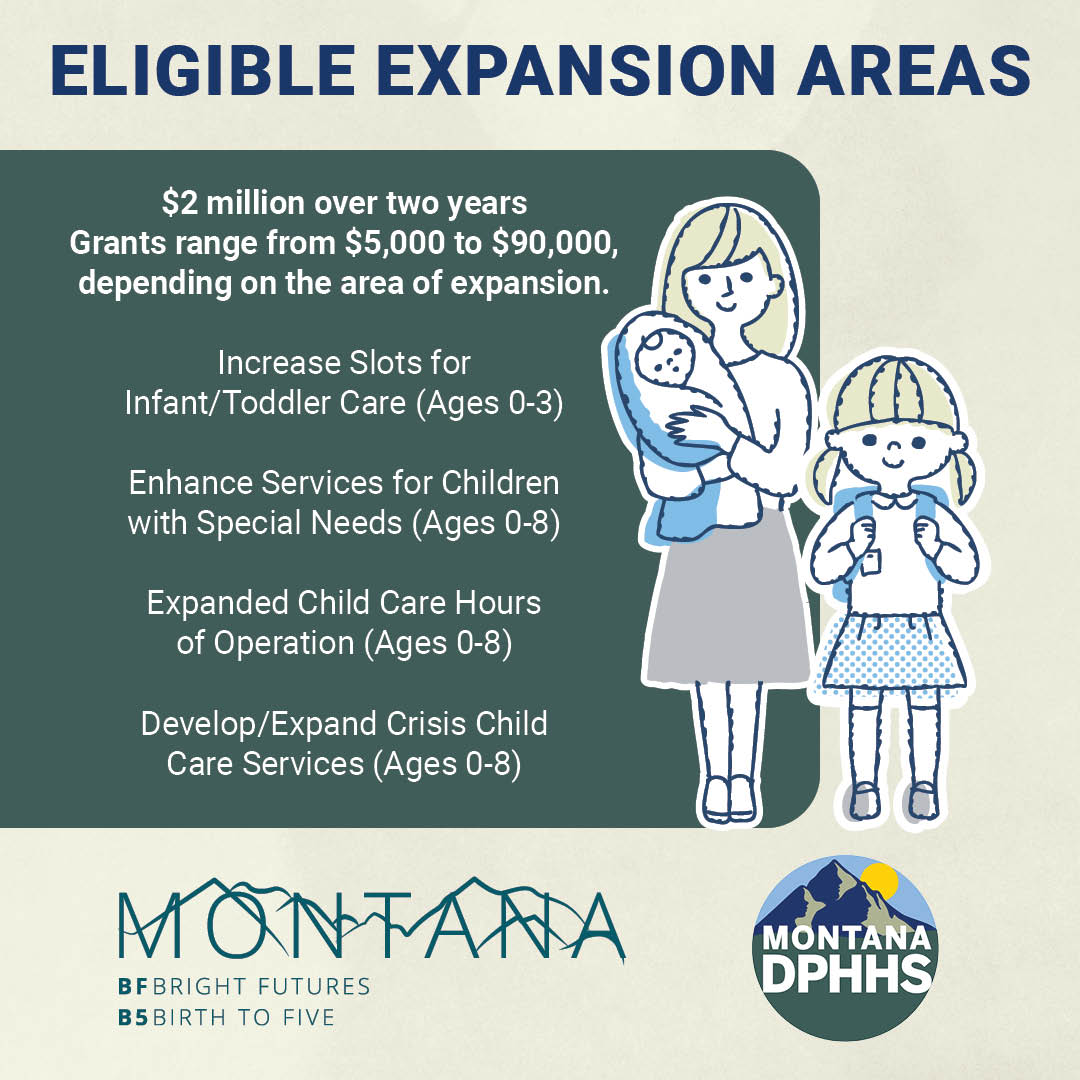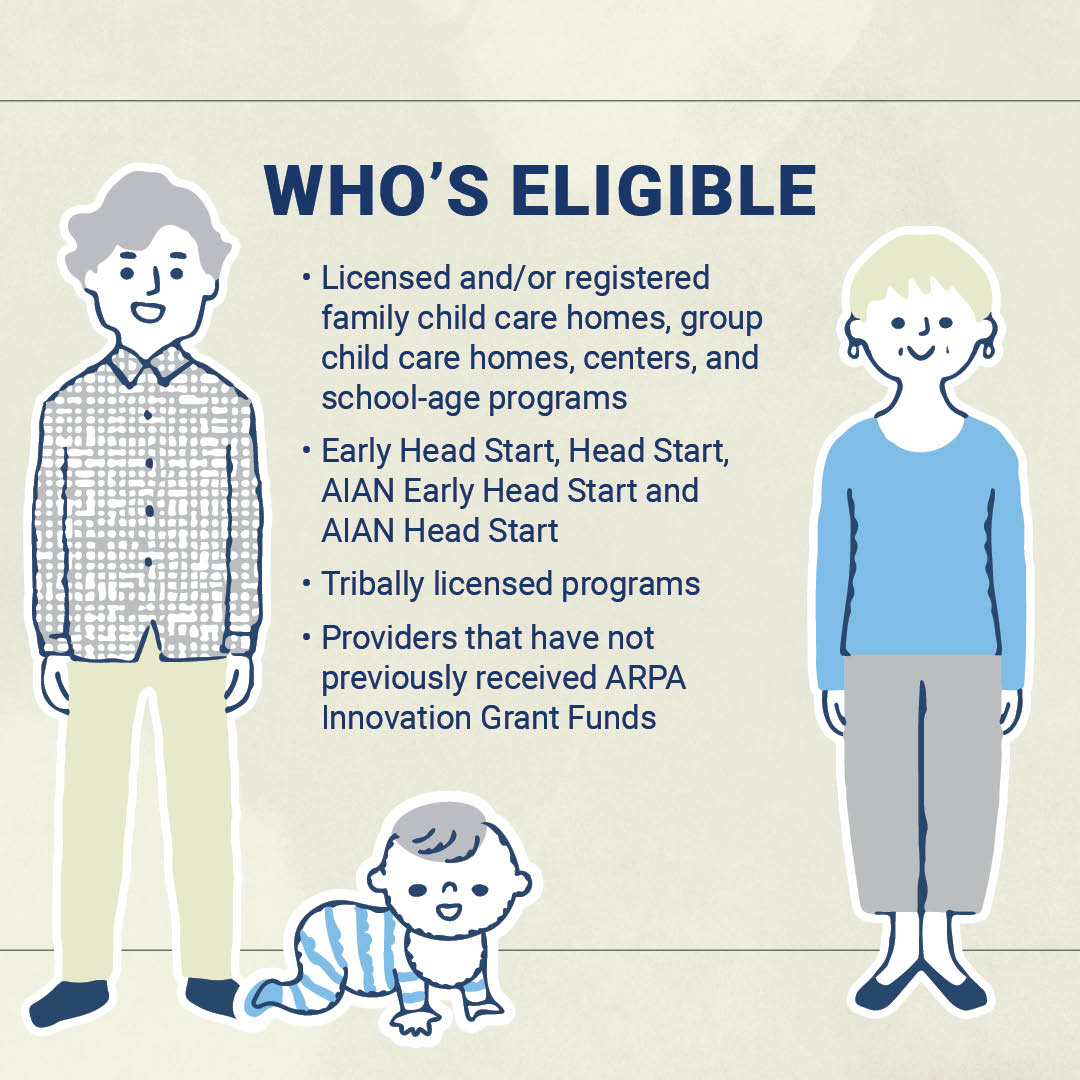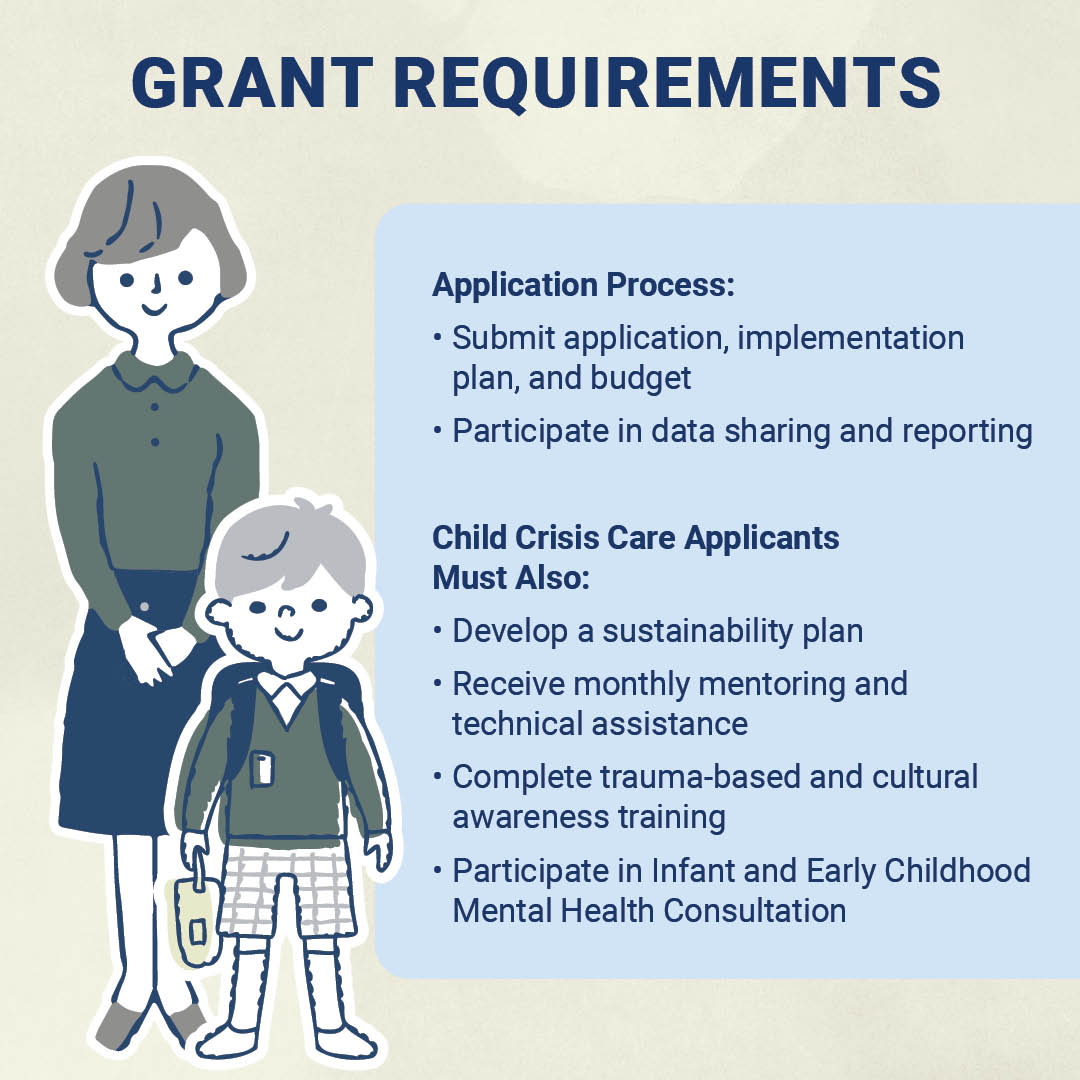
A Grant to Grow and Strengthen Montana's Early Childhood System
The State of Montana received the PDG B-5 Renewal Grant of $24 million over three years, 2023-2025. The grant serves as an exciting funding opportunity through the Administration for Children and Families (ACF) at the Department of Health and Human Services (HHS) and the Department of Education to support the Bright Futures B-5 Project in Montana.
The focus of the grant is building the early childhood system birth through age 5. The Early Childhood and Family Support Division is implementing a 3 year grant through December 2025.
2025 Statewide Needs Assessment and Strategic Plan
2025 Early Childhood Needs Assessment
The 2025 Early Childhood Needs Assessment was written to provide a complete overview of Montana’s early childhood education and care system, including young children, families, service providers, and the systems that support them. The primary goals were to describe the current state of early childhood care and education, identify obstacles and opportunities related to service access, quality, and fairness, and offer practical recommendations to improve outcomes and reinforce the statewide system. The assessment utilized multiple data sources from statewide surveys, family and provider interviews, public datasets, and findings from previous reports. Ongoing stakeholder involvement was essential in shaping and fine-tuning the final recommendations.
In 2024–2025, under the Bright Futures Birth to Five (BFB5) program, Montana undertook a renewed planning process to adapt to evolving conditions and define a clear path forward. This updated 2025 Strategic Plan directly builds on the findings of the 2025 Early Childhood Needs Assessment and includes extensive stakeholder engagement throughout the state. Surveys, interviews, meetings, and focus groups with families, tribal leaders, early learning providers, home visitors, health and mental health professionals, administrators, coalitions, and policymakers helped identify urgent needs and actionable priorities.
Bright Futures Birth to Five Slot Expansion Grants



*Please Note:
- Grant awards have been announced. Please check your email through Submittable.
- In order to receive federal funding, your UEI status must show active registration. For assistance with UEI#s, please contact Montana Apex through the Montana Apex website.
The Frequently Asked Questions (FAQs) below are updated regularly as BF B5 receives questions.
- Expanding Services Frequently Asked Questions (FAQ)
- Crisis Child Care Frequently Asked Questions (FAQ)
For additional questions please email us at pdgb5@mt.gov.
Programs and Incentives

Child Care Assistance for Child Care Workers
Due to the ending of Bright Futures B-5 grant funds, no new applications for the Child Care Worker program will be accepted after July 31, 2025. Best Beginnings staff will communicate directly with families concerning changes in subsidy for current enrollees beginning August 1, 2025. Our aim is to give 60 days notice before a family is no longer eligible or has an increase in copayment. For additional information or questions please contact the Child Care Agency working with you.
Grant Information
2025 Statewide Needs Assessment
2025 Strategic Plan
2025 Comprehensive Fiscal Analysis (CFA) - *Coming Soon*
2022 PDG Grant Application
State Press Release
Crisis Child Care Centers - Nonstop Local ABC Fox
DPHHS said it anticipates the universal home visiting program and the crisis child centers will be two of approximately 10 other strategies...
State Announces $24M Investment- NBC Montana
The project is designed to increase access to quality child care, promote healthy families and address child care workforce staffing...
Universal Home Visiting - The Livingston Enterprise
State Health Department to receive $24 million in federal funds for childcare services...
Activity 1: Needs Assessment
Montana’s comprehensive statewide needs assessment analyzed early childhood system strengths and gaps related to access, quality, workforce, coordination, family engagement, and governance.
Strengthening Montana's Early Childhood System: A Comprehensive Statewide Needs Assessment
Activity 2: Strategic Plan
The strategic plan was developed May—July 2019, with a significant focus on engaging family and provider voices throughout the process. Montana’s early childhood strategic plan reflects the state’s approach to implementing a five-year effort toward strengthening the state’s early childhood system, with a focus on enhancing its early care and education mixed delivery system for children birth through five, particularly for vulnerable children.
Strengthening Montana's Early Childhood System: Strategic Plan
Activity 3: Maximizing Family Choice and Knowledge
Families are children’s first and most important teachers. Montana wants to empower families to nurture their children’s learning and development across the early childhood system. Family engagement strategies include:
- Further defining family engagement.
- Improved, culturally competent information sharing about ECE.
- Investing in family engagement coordinators in local early childhood coalitions.
- Improving early childhood resource and referral processes.
- Increased screening for social-emotional health.
Activity 4: Sharing Best Practices among State ECE and Education Providers
The quality of education and care Montana’s children receive is largely dependent on the quality of the state’s ECE workforce and the early childhood system supporting them. Montana is using this grant to strategically invest in professional development and capacity building for early childhood system providers so they can excel in their work. The state is approaching this activity of sharing best practices among state ECE providers through three primary strategies:
- Sharing best practices across the early childhood system.
- ECE provider professional development.
- ECE targeted learning communities.
Activity 5: Improving Overall Quality of ECE Programs, Providers, and Services
Montana is approaching this activity of improving the overall quality of ECE programs, providers, and services through four primary strategic areas of focus:
- Increasing early childhood system coordination and collaboration.
- Improving data systems.
- Increasing ECE system capacity to improve access and quality for underserved populations and regions.
- Improving school readiness and transitions.
Resources:
PDG B-5 is a competitive federal grant program established in December 2015 as part of the bipartisan Every Student Succeeds Act (ESSA)
History of PDG Funding in Montana:
Montana received its first Preschool Development Grant in 2014 in the amount of $10,000,000 per year for four years. This grant was Preschool focused and allowed Montana to increase Preschool slots in school districts and Head Start programs, increase workforce, develop infrastructure and site capacity and more. OPI was the lead on the grant and partnered closely with DPHHS.
In 2019, DPHHS applied for and received the Preschool Development Planning Grant Birth to Five, a $6 million infrastructure grant to develop the early childhood system. Out of this grant came the Early Childhood and Family Support Division, ParentingMontana.org as well as an extensive needs assessment and strategic plan used to inform ARPA work in Montana.
In 2019, DPHHS applied for the very competitive Preschool Development Grant Birth to Five Renewal and was not successful. Many projects and processes listed in the grant have moved forward with ARPA and other funding.
Finally, in 2022, DPHHS wrote for and received a second round PDG B-5 Renewal Grant to continue the work of the planning grant from 2019. As of 2025, this grant is in its third year of implementation.
Grant Activities
- Update needs assessment
- Revise the strategic plan
- Maximize parent and family engagement
- Support the early childhood workforce and disseminate best practices
- Support overall quality improvement
- Enhance quality and expand access to existing and new programs
- Monitor, evaluate, and use data for continuous improvement
Expected Long-Term Outcomes
- Montana’s families with young children have increased access to, and participation in high quality early care and education across a mixed delivery system
- Montana’s early childhood workforce is confident and effective, due to enhanced ECE professional development
- The early childhood system is coordinated to support effective family assessment, system navigation, care coordination, and use of data
- Montana’s families are engaged and valued as partners in the early childhood system
- Montana’s communities make early childhood a priority, and act to support children’s health, learning, and well-being
- Montana’s early childhood system is structured to support policy alignment, strategic financing, continuous improvement, and accountability
Project Highlights
- Universally Offered Home Visiting pilot
- Child Care Expansion pilot
- Child Care Worker Subsidy Support program
- Employer Recruitment and Retention strategies
- Expand Apprenticeship and Pre-Apprenticeship programs
- Professional Development opportunities
- Early Childhood Integrated Data System (ECIDS)
- STARS to Quality - Redesign
- Comprehensive Cost of Early Childhood System study
Partners
Montana believes strong collaboration is essential to success. In writing the Bright Futures B-5 Grant, the state renewed its commitment to hear from and work with a variety of stakeholders, including families, and private and governmental partners.
Below is a list of stakeholders engaged in the grant writing process and who signed a letter of commitment. We are excited to galvanize current and new stakeholders in the work needed to accomplish grant objectives.
- Child and Family Services Division (CFSD)
- Department of Labor and Industry (DLI)
- Healthy Mothers, Healthy Babies (HMHB)
- Montana Child Care Resource and Referral (CCRR) agencies
- Montana Early Childhood Advisory Council (MECAC)
- Montana Early Childhood Project (ECP)
- Montana Head Start Association (HSA)
- Montana Infant and Early Childhood Home Visiting (MIECHV) program
- The Office of Public Instruction (OPI)
- Raise Montana
- Zero to Five Montana
Questions?
Do you have a question or comment about the Montana Bright Futures Birth to Five Project? Click here to submit your question and it will be shared with a BF-B5 staff member.
This website is supported by Grant Number 90TP0101 from the Office of Early Childhood Development within the Administration for Children and Families, a division of the U.S. Department of Health and Human Services. Neither the Administration for Children and Families nor any of its components operate, control, are responsible for, or necessarily endorse this website (including, without limitation, its content, technical infrastructure, and policies, and any services or tools provided). The opinions, findings, conclusions, and recommendations expressed are those of Montana DPHHS and do not necessarily reflect the views of the Administration for Children and Families and the Office of Early Childhood Development.

